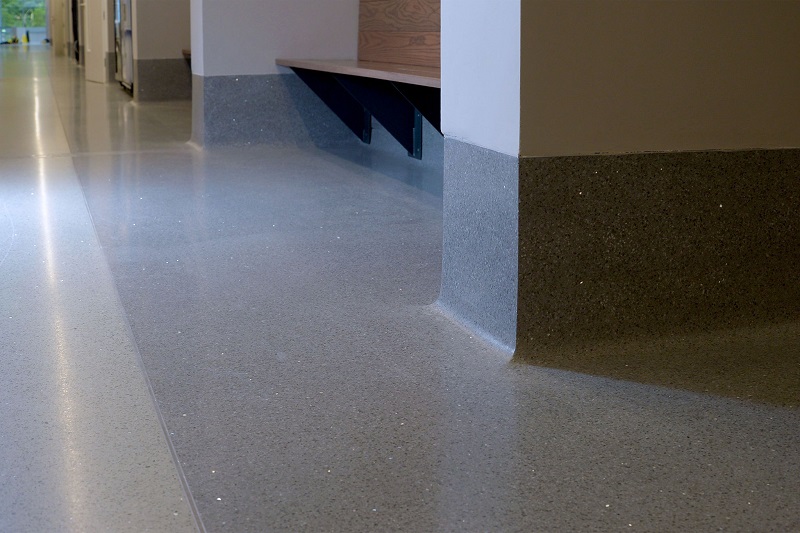Resin

|
| Resin flooring |
Contents |
[edit] Introduction
Resin is a very broad term used in many applications but typically it describes a synthetic plastic material that has many applications in the construction industry, usually in conjunction with other materials.
Synthetic resins typically comprise synthetic resinous compounds formed by the condensation or polymerisation of:
- Formaldehyde and urea.
- Phenol and formaldehyde.
- Phthalic anhydride and glycerol.
- Polyamides, vinyl derivatives and other sources.
[edit] Synthetic resin adhesive (SRA)
SRAs are made from thermosetting resins such as urea or phenol formaldehyde with the addition of an accelerator to regulate the setting process. They may also be made from thermo-plastic resins such as polymethylmethacrylate or polyvinyl acetate. There are many types on the market, including acrylic resins, MMA (methyl methacrylate) resins and epoxy resins.
[edit] Epoxy resin
Epoxy resin adhesives are used for bonding a wide range of building materials together e.g brick, concrete, metal, stone and wood. Epoxy resin has many applications, including being added to floor screeds to create a durable, non-slip surface; to make waterproof, durable flooring for footbridges, ramps, loading bays, roadways and wet-working environments; added to mortars, coatings and adhesives to impart strength and water resistance; and for injecting cracks in bricks, block, render and concrete.
[edit] Building applications incorporating resin
[edit] Glass reinforced plastic
Glass reinforced plastic GRP is a composite, laminate material produced by impregnating a cloth of woven glass fibres [1] with a synthetic resin, usually polyester-based. It can be mass produced or built-up by hand and, after curing, forms a complex matrix of plastic and glass fibre. It is sometimes referred to as glass reinforced polyester, fibreglass, glass-fibre reinforced plastic (GFRP), fibre reinforced plastic (FRP) or fibre reinforced polymer (FRP).
The composite properties of high-strength glass-fibre and highly resilient plastic make GRP strong, lightweight and weather- and corrosion-resistant. It can also be manufactured to be fire retardant. It is therefore suitable for a very wide range of applications such as cladding panels, boat building, car bodies, cabinets and helmets.
[1] Molten glass that is that is extruded through a die into fine fibres which can then be spun into threads and woven into tapes and cloths.
For more information see: Glass reinforced plastic.
[edit] Plywood
Resin-bonded plywood comprises layers of wood veneer stacked one on top of the other and held together with synthetic resin, glue or glue-impregnated paper; the application of pressure and heat establishes the final product. It is usually water resistant and durable and can be suited to external use.
For more information see: Plywood
[edit] Resin driveways
Resin driveways are created by binding together small-stone aggregates with a resin, usually polyurethane based. The result is typically permeable and may be suitable for inclusion in sustainable urban drainage schemes (SUDS).
There are two types:
- Resin bound systems – these tend to be more popular resulting in a smooth, decorative surface of uniform appearance and durability. They are made by mixing selected coloured aggregates together with a specialist resin. The mix is hand-trowelled until smooth.
- Resin bonded – resin is applied to an existing prepared surface onto which aggregates are scattered, mimicking the appearance of loose gravel.
[edit] Related articles on Designing Buildings Wiki
Featured articles and news
RTPI leader to become new CIOB Chief Executive Officer
Dr Victoria Hills MRTPI, FICE to take over after Caroline Gumble’s departure.
Social and affordable housing, a long term plan for delivery
The “Delivering a Decade of Renewal for Social and Affordable Housing” strategy sets out future path.
A change to adoptive architecture
Effects of global weather warming on architectural detailing, material choice and human interaction.
The proposed publicly owned and backed subsidiary of Homes England, to facilitate new homes.
How big is the problem and what can we do to mitigate the effects?
Overheating guidance and tools for building designers
A number of cool guides to help with the heat.
The UK's Modern Industrial Strategy: A 10 year plan
Previous consultation criticism, current key elements and general support with some persisting reservations.
Building Safety Regulator reforms
New roles, new staff and a new fast track service pave the way for a single construction regulator.
Architectural Technologist CPDs and Communications
CIAT CPD… and how you can do it!
Cooling centres and cool spaces
Managing extreme heat in cities by directing the public to places for heat stress relief and water sources.
Winter gardens: A brief history and warm variations
Extending the season with glass in different forms and terms.
Restoring Great Yarmouth's Winter Gardens
Transforming one of the least sustainable constructions imaginable.
Construction Skills Mission Board launch sector drive
Newly formed government and industry collaboration set strategy for recruiting an additional 100,000 construction workers a year.
New Architects Code comes into effect in September 2025
ARB Architects Code of Conduct and Practice available with ongoing consultation regarding guidance.
Welsh Skills Body (Medr) launches ambitious plan
The new skills body brings together funding and regulation of tertiary education and research for the devolved nation.
Paul Gandy FCIOB announced as next CIOB President
Former Tilbury Douglas CEO takes helm.
UK Infrastructure: A 10 Year Strategy. In brief with reactions
With the National Infrastructure and Service Transformation Authority (NISTA).






















